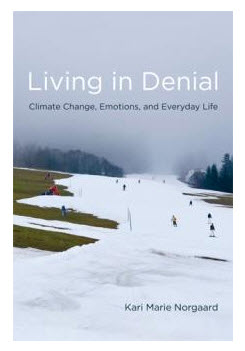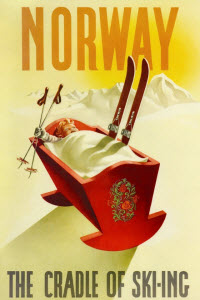Living in Denial in Norway
Norway is one of the most wealthy countries on Earth, with the very highest levels of human development, it is among the most generous donors of foreign aid and, for a country of its size, makes enormous efforts to promote peace. A former Prime Minister of Norway, Gro Harlem Brundtland, has done as much as anyone to promote global sustainable development and public health. The world would surely be a better place if everyone on Earth behaved like Norwegians.
Norway, on the other hand, is also the largest per capita oil producer outside of the Middle East, producing more oil per capita even than Saudi Arabia, about 150 barrels per person per year from its fields in the North Sea. Five million Norwegians also emit 11 tonnes of greenhouse gasses each per year, a little higher than the European mean and twice as high as the global average. The world would surely become uninhabitable if everyone on Earth behaved like Norwegians.
 Every other country and community has its own contradictions, of course. Despite the fact that the majority of Americans and Canadians believe that climate change is a concern, no progress has been made at national levels to introduce the carbon pricing policies that institutions like the International Energy Agency and the World Bank believe to be an essential step in reducing emissions. And neither, generally speaking, have many people voluntarily made the lifestyle changes—like giving up non-essential air travel—that are necessary if we are to achieve a low-carbon future. Concern about climate change is broad, but often shallow. We mostly carry on in our daily lives as if climate change was not happening.
Every other country and community has its own contradictions, of course. Despite the fact that the majority of Americans and Canadians believe that climate change is a concern, no progress has been made at national levels to introduce the carbon pricing policies that institutions like the International Energy Agency and the World Bank believe to be an essential step in reducing emissions. And neither, generally speaking, have many people voluntarily made the lifestyle changes—like giving up non-essential air travel—that are necessary if we are to achieve a low-carbon future. Concern about climate change is broad, but often shallow. We mostly carry on in our daily lives as if climate change was not happening.
Among the majority of us who recognize the threat of climate change, there’s clearly a disconnection between thought and action. We know that things have to change, but we have a lot of reasons why change is not up to us, or why now is not the time, or why our inaction is somebody else’s fault. The exact reasons will vary from person to person and from country to country, but they all serve the same purpose, to help ease the anxiety and helplessness we all feel, while doing nothing substantial to alleviate the problem. Kari Norgaard, an American and a sociology professor at the University of Oregon, calls these responses “socially organized denial” and has written several articles on the subject (available here) and a book, Living in Denial: Climate Change, Emotions and Everyday Life (MIT Press, 2011) based on sociological field work that she conducted in rural Norway.
Shades of denial
Before looking at methods or results, let’s clarify some terminology. Norgaard recognizes three kinds of denial:
- Literal denial. This is the outright refusal to believe the facts and to dispute the consensus science, and even to deny the existence of a scientific consensus. Many so-called “climate skeptics” fit into this category.
- Interpretive denial. This involves not disputing the underlying reality, but using euphemisms and framing to distort meaning. An example of this kind of denial might be the Government of Alberta claiming that it is improving emissions intensity (emissions per barrel) from the oil sands, while absolute emissions of CO2 are increasing rapidly due to growing bitumen production.
- Implicatory denial. Here, the facts are not denied or re-interpreted, but instead "the psychological, political or moral implications that conventionally follow" from those facts are denied or ignored. Implicatory deniers accept the reality of human-caused climate change, but they live their lives as if the problem was little to do with them. This variety of denial is the main focus of the book. Most of us who live at a high standard of living in developed countries are guilty to some degree of implicatory denial.
“Socially organized denial” refers to the way in which communities find a way to approach a problem, reconciling it with their standards and traditions, or inventing new ones. It falls somewhere in between politically organized denial, in which organizations deliberately attempt to influence the reaction of the public to an issue, and psychological denial, which is an individual’s response to an unpleasant reality. Rural Norway provides a particularly good study area for socially organized denial, since the people there have been relatively isolated from the deliberate attempts in the United States to influence public opinion and spread misinformation on climate change, as is documented in books like Merchants of Doubt.
It is not possible to summarize all of Living in Denial in a short essay, so I will restrict myself to a few examples. I would recommend it to anyone with an interest in how people respond to the climate crisis. Although this is a scholarly book on sociology, it is nevertheless readable, relatively free of jargon and packed with insights and deserves to be read more widely by non-specialists.
The cradle of skiing
Norgaard spent a year living and working in Bygdaby; a fictional name given to a settlement of 14,000 people in the mountains of central Norway. (There are enough clues in the book to allow the curious to figure out the real name of the town.) Her approach was rather like an ethnographer’s. She lived and worked in the community: observing and participating in the rites of everyday life; engaging a cross-section of the people in conversations; and recording and interpreting the results. The focus of the conversations was on climate change, and how people reconcile the wealth of their society and their county’s status as a major oil producer with their reverence for nature and their modern lifestyles.

In the winter of 2000, Bygdaby’s ski hill opened weeks later than usual and only with the help of artificial snow. The ski hill is an important part of the local economy and, importantly, skiing is an essential element of the local culture and national identity. Skiing originated in Norway and there is evidence that the people of the region were skiing there in 5000 BC, before the Egyptian Pyramids were built and closer in time to the Younger Dryas than to the date of discovery of oil under the North Sea. Norgaard writes:
During winter, the recreational activity of skiing connects people to the past. Skiing is not only a practice with a very long local history, but also an activity that takes place in the utmark, uncultivated land (usually in the mountains where sheep and cows grazed in the summers). A trip into the utmark is thus an opportunity to review the history of the landscape.
Shortened ski seasons—a result of climate change—threaten, over the space of just a few generations, to disrupt the traditions and sense of identity of a people that have endured for millennia. A response to this, Norgaard reports, is reluctance by many even to consider a link with the unintended consequences of the modern industrial economy of Norway to changes in the climate. She notes also recent trends in the local culture toward reaffirmation of historical traditions and a revived emphasis on cultural links to the past. When the way ahead is uncertain and threatening, looking backwards, it seems, can be more comforting than watching where you are going.
“Norway is a little land”, more virtuous than “Amerika”
Many people who accept the basic science behind climate change, and who acknowledge that serious harm is being done to the planet, may feel both powerless and guilty, often at the same time. The stressful feelings that arise from this can be dealt with either by ignoring the problem altogether or by finding a way of approaching the problem that lets you off the hook. It is even more satisfying if your neighbours readily buy into the same story line.
Norgaard found that a common talking point was that people would say that “Norway is a little land”. By this people meant that a country of 5 million people could have little influence at a global scale. In this view, Norwegians could drastically reduce their carbon emissions and it would just be a drop in the bucket, a meaningless gesture of sacrifice made while the billions of people in China and India are rapidly building power stations and expanding their coal consumption. Nobody could blame anyone—the logic goes—for failing to make a sacrifice that would have no measurable benefit. This has the advantage of being able to declare yourself practically-minded and, most importantly, innocent.
On the other hand, Norwegians take considerable pride, justifiably so, in the leadership that their “little land” has taken in fostering world peace, with important peace-brokering initiatives in Myanmar, Syria, Palestine, Sri Lanka and elsewhere. On the environment, Norway was the first country, in 1989, to institute national targets for carbon emissions; although these targets would later be quietly dropped and replaced with an approach to stabilising greenhouse gas emissions as an international problem, to be addressed through the Kyoto mechanisms. According to Norgaard, these “claims to virtue” helped to justify other actions that, on their own, might appear to be irresponsible.
“Claims to virtue” are reinforced when Norwegians compare themselves to “Amerika”. Norgaard uses the Norwegian spelling to distinguish the “Mythic America” image that Norwegians have of the United States—Norgaard's home—from the complicated reality of that country. The concept of Amerika, she argues, reveals more about Norway than it does about America, with the focus on stereotypes such as Hollywood and Disneyland, while scorning the reckless consumerism and irresponsibility of Americans; maintaining, for example, that 70% of Americans value their cars more than their families. A self-righteous comparison with a partly invented Amerika, allows Norwegians to claim that they are not like them: “We may have our problems, but we are still doing better than that”.
Norgaard’s observations are made dispassionately; they are neither particularly judgemental nor sympathetic. Her point, of course, is not to single out any one country for criticism. But by taking a hard look at how another culture justifies its response to the challenge presented by climate change, we might just learn something about our own.
A cultural comb-over
Paul Graham, a programmer, venture capitalist and essayist wrote in The Age of the Essay:
I've always been fascinated by comb-overs, especially the extreme sort that make a man look as if he's wearing a beret made of his own hair. Surely this is a lowly sort of thing to be interested in-- the sort of superficial quizzing best left to teenage girls. And yet there is something underneath. The key question, I realized, is how does the comber-over not see how odd he looks? And the answer is that he got to look that way incrementally. What began as combing his hair a little carefully over a thin patch has gradually, over 20 years, grown into a monstrosity. Gradualness is very powerful.

Famous wearers of comb-overs include the English footballer Sir Bobby Charlton and the scientist and writer Jared Diamond. However, the mother of all comb-overs is the one sported by the American financier Donald Trump. Trump is notorious for his inexhaustible self-esteem and we can be confident that when he looks in the mirror he is pleased with what he sees. Objective observers, though, are more likely to be more amused than impressed by his elaborate coiffure.
Like a comb-over, socially organized denial develops in small increments. It is not a storyline that is plotted and composed by any single author, public relations company or government agency, but a tacitly agreed-upon narrative that gradually emerges from within a community. And like a comb-over, the artifice deceives nobody forever, except perhaps for the person looking at himself in the mirror, who, in most cases, would be happier if others didn’t stare too closely.
When reading Living in Denial, what is striking is not the description of the unusual or exotic aspects of Norwegian culture—although there is that, too—but, on almost every page, encountering attitudes that are surprisingly familiar. After taking Kari Norgaard’s guided tour through the society of rural Norway, upon your return you may never look at your own circle of friends, colleagues and neighbours—especially the way in which they and you respond to the challenge of climate change—in quite the same way again.
A follow-up article Living in Denial in Canada will examine implicatory denial of climate change in that country.
Posted by Andy Skuce on Thursday, 28 February, 2013
 Every other country and community has its own contradictions, of course. Despite the fact that the majority of Americans and Canadians believe that climate change is a concern, no progress has been made at national levels to introduce the carbon pricing policies that institutions like the International Energy Agency and the World Bank believe to be an essential step in reducing emissions. And neither, generally speaking, have many people voluntarily made the lifestyle changes—like giving up non-essential air travel—that are necessary if we are to achieve a low-carbon future. Concern about climate change is broad, but often shallow. We mostly carry on in our daily lives as if climate change was not happening.
Every other country and community has its own contradictions, of course. Despite the fact that the majority of Americans and Canadians believe that climate change is a concern, no progress has been made at national levels to introduce the carbon pricing policies that institutions like the International Energy Agency and the World Bank believe to be an essential step in reducing emissions. And neither, generally speaking, have many people voluntarily made the lifestyle changes—like giving up non-essential air travel—that are necessary if we are to achieve a low-carbon future. Concern about climate change is broad, but often shallow. We mostly carry on in our daily lives as if climate change was not happening.


